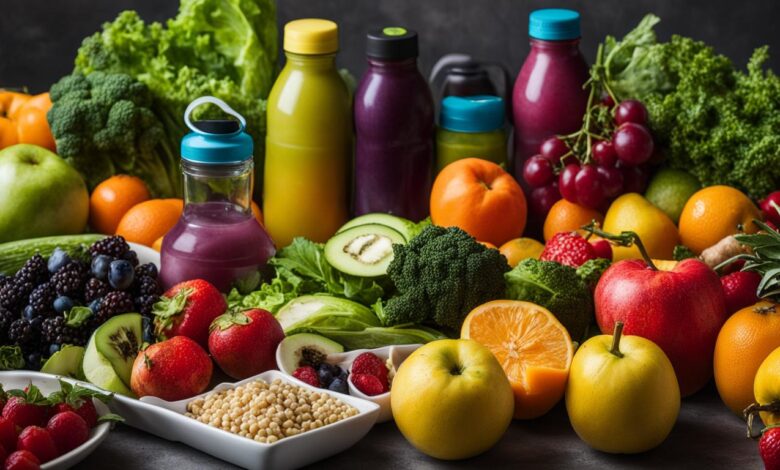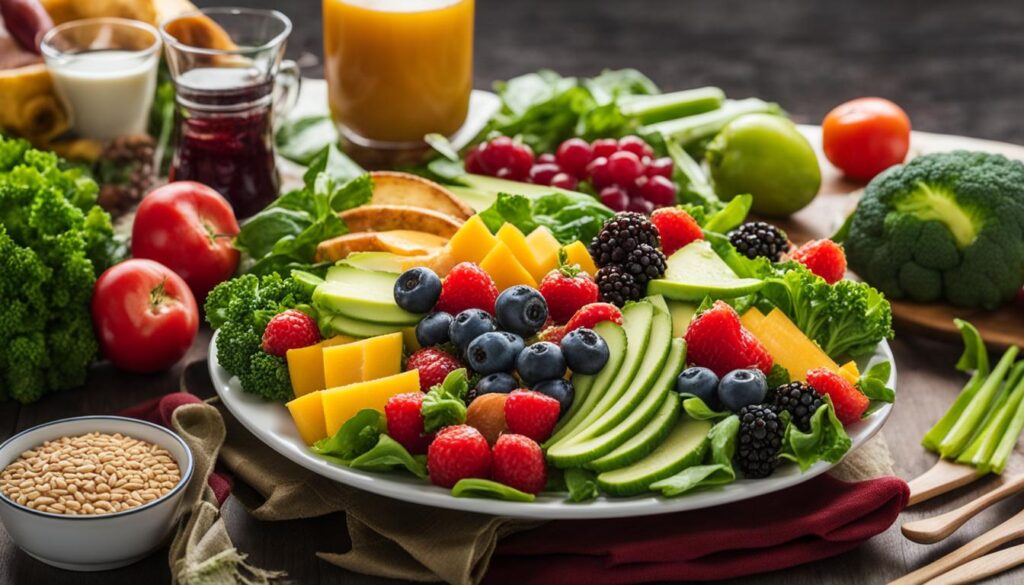Optimal Recovery Meals for Endurance Cyclists

Fueling properly before and during a ride is important for performance, but the post-workout meal is equally crucial for recovery. It’s essential to replenish the body with the right nutrients to enhance performance and speed up recovery. Carbs and protein are key components of a recovery meal, as carbs replenish glycogen stores and protein repairs and builds muscles. The amount of carbs and protein needed depends on the length and intensity of the ride. Eating something, even if it’s unhealthy, is better than eating nothing at all, but it’s best to opt for healthier options that are higher in carbs and lower in fat.
Key Takeaways:
- Replenishing the body with the right nutrients post-workout is essential for optimal recovery.
- Carbs and protein are crucial components of a recovery meal, replenishing glycogen stores and promoting muscle repair.
- The amount of carbs and protein needed varies based on the length and intensity of the ride.
- Opt for healthier options that are higher in carbs and lower in fat for optimal recovery.
- Even if it’s unhealthy, eating something is better than eating nothing after a ride.
Importance of Carbs and Protein in Recovery
Carbs and protein play crucial roles in the recovery process after a ride. Carbohydrates are essential for glycogen repletion, the process of replenishing the body’s glycogen stores that are depleted during exercise. Failure to replenish these carbs can lead to feelings of sluggishness and weakness, as well as hinder the recovery process.
Protein, on the other hand, is vital for muscle repair and growth. Intense exercise causes micro-tears in the muscle fibers, and protein helps to repair and rebuild these damaged tissues. Inadequate protein intake can impede the recovery process, leading to prolonged muscle soreness and delayed progress.
The recommended amount of carbs and protein to consume after a ride varies based on the length and intensity of the exercise. Longer or more intense rides require higher carb intake to ensure proper glycogen replenishment and optimal recovery. It’s important to spread protein intake throughout the day, as the body can only absorb a certain amount at one time.
However, it’s crucial to note that immediately after a ride, fat and fiber should be limited in the post-workout meal. This is because fat and fiber can slow down digestion, impairing the absorption of carbohydrates and protein. It’s best to prioritize easily digestible carbs and lean sources of protein during this crucial recovery period.
| Ride Length | Ride Intensity | Carb Intake | Protein Intake |
|---|---|---|---|
| Less than 1 hour | Low to moderate | 0.5-0.7 grams of carbs per pound of body weight | 0.2-0.3 grams of protein per pound of body weight |
| 1-3 hours | Low to moderate | 0.7-1.0 grams of carbs per pound of body weight | 0.3-0.4 grams of protein per pound of body weight |
| 3-5 hours | High | 1.0-1.5 grams of carbs per pound of body weight | 0.4-0.5 grams of protein per pound of body weight |
| 5+ hours | High | 1.5-2.0 grams of carbs per pound of body weight | 0.5-0.6 grams of protein per pound of body weight |
Note: These values are general recommendations. Individual preferences and goals may vary.
Optimal Post-Workout Nutrition Timing
Timing is crucial when it comes to post-workout nutrition. To maximize glycogen repletion and muscle recovery, it’s best to consume a recovery meal or snack within 30 to 60 minutes after exercise. This window of opportunity allows the body to absorb carbs and protein more effectively, promoting efficient recovery.
Waiting too long to eat can result in slower glycogen replenishment and delayed muscle recovery. Therefore, it’s important to have a plan in place for post-workout nutrition, ensuring that pre-planned snacks or meals are easily accessible. By being prepared, you can capitalize on the post-exercise period and facilitate optimal recovery.
Liquid options such as chocolate milk or fruit smoothies can be refreshing and provide essential nutrients in an easily digestible form. These options can be particularly beneficial for individuals who prefer lighter post-workout meals or have limited time to prepare a full meal.
Here’s a table summarizing the benefits of timing your post-workout nutrition:
| Benefits of Optimal Timing |
|---|
| Enhanced glycogen repletion |
| Accelerated muscle recovery |
| Improved nutrient absorption |
| Faster muscle repair and growth |
By following a strategic post-workout nutrition timing plan, you can ensure that your body receives the necessary fuel to restore glycogen levels and support muscle recovery. This, in turn, will help optimize your performance and progress towards your fitness goals.
The Role of Hydration in Recovery
Hydration is a vital aspect of the recovery process for endurance cyclists. After a ride, it’s crucial to rehydrate and replace the fluids and electrolytes lost through sweat. Proper hydration aids in replenishing the body and optimizing the recovery phase, ensuring that athletes can perform at their best in subsequent workouts.
Sipping water or an electrolyte drink is sufficient for shorter and easier rides, but longer or more intense rides require more significant fluid replacement. Athletes must be mindful of their fluid loss and aim to replace 100-150% of the lost fluids within one to four hours after exercise.
To estimate fluid loss, cyclists can weigh themselves before and after a ride. This approach provides valuable insights into the amount of fluid that needs to be replenished. Athletes who train in extreme environmental conditions, such as high heat or humidity, may need to incorporate electrolyte replacement drinks to restore the body’s electrolyte balance effectively.
Here are a few key factors to consider regarding hydration in recovery:
- Fluid replacement is essential for rehydration and to counteract fluid loss from sweat.
- Electrolyte balance must be maintained to support proper muscle function and prevent cramping.
- Timing is crucial, as rehydration should begin soon after finishing the ride.
To provide a visual representation of the importance of hydration in recovery, here’s a simple table outlining the fluid replacement recommendations:
| Ride Duration | Fluid Loss | Fluid Replacement |
|---|---|---|
| Shorter or easier rides | Low fluid loss | Sip water or electrolyte drink |
| Longer or more intense rides | Significant fluid loss | Replace 100-150% of the lost fluids within one to four hours |
It’s essential for endurance cyclists to prioritize hydration in their recovery routine. By replenishing fluids and electrolytes, athletes can facilitate optimal recovery and ensure their bodies are ready for future training sessions and races.
Consuming the Right Calories for Recovery
Consuming the right amount of calories is crucial for effectively recovering after a ride. Within two hours of completing your ride, it is essential to consume a substantial post-ride meal that replenishes the carbohydrates used during exercise and provides the necessary nutrients for muscle repair and growth. This meal should consist of lean proteins, complex carbs, and minimal fats to facilitate digestion and the delivery of vital nutrients to your muscles.
When it comes to protein sources, options such as eggs, chicken, tuna, or tofu are excellent choices. These lean proteins provide essential amino acids for muscle repair and growth. In terms of carbohydrates, focus on incorporating whole grain pasta, rice, or sweet potatoes into your meal to replenish glycogen stores effectively. These complex carbs provide sustained energy and support the recovery process.
Avoid excessive fat intake in your post-ride meal as it can slow down digestion and hinder the delivery of carbs and protein to your muscles. Opt for healthier fats, such as those found in avocados or nuts, in moderation.
To optimize your recovery, consider eating smaller portions of protein and carbohydrates every two to three hours after your training session. This approach ensures a continuous supply of nutrients to fuel muscle repair and enhance the recovery process.

| Food Category | Examples |
|---|---|
| Lean Proteins | Eggs, Chicken, Tuna, Tofu |
| Complex Carbs | Whole grain pasta, Rice, Sweet potato |
| Healthy Fats | Avocados, Nuts |
By consuming the right calories through a substantial post-ride meal, you provide your body with the necessary fuel for optimal recovery. Remember to adjust your calorie intake based on the intensity and duration of your ride to ensure adequate carbohydrate replenishment and muscle repair.
Additional Techniques for Optimal Recovery
Alongside proper nutrition, sleep, rest, and stretching are vital for recovery. These techniques help the body return to its normal physiological state and aid in muscle repair and growth. When it comes to sleep, aim for 7-9 hours of quality rest each night. During sleep, the body releases growth hormone, which is essential for muscle recovery and repair. Creating a sleep-friendly environment, such as a cool and dark room, can promote better sleep quality.
Resting between workouts is equally important. Allow your body time to recover and recharge by including rest days in your training schedule. Active recovery, like light cycling or swimming, can be beneficial on rest days as it promotes blood flow to the muscles without adding significant strain.
Stretching is another crucial aspect of recovery. Incorporate dynamic stretching before your workouts to warm up the muscles and improve flexibility. After your workouts, perform static stretches to help elongate and relax the muscles. Stretching can reduce muscle soreness and enhance overall range of motion.
“Proper recovery techniques are just as important as intense training. They allow the body to repair, rebuild, and grow stronger, ultimately improving performance.”– Professional Cyclist
Supplements can also aid in the recovery process. Omega 3 fatty acids are known for their anti-inflammatory properties and can help reduce muscle inflammation and soreness. Tart cherry juice contains natural antioxidants that may alleviate muscle fatigue and promote faster recovery.
Taking an individualized approach to recovery can further optimize results. Biomarkers can provide valuable insights into your body’s specific needs and help tailor recovery strategies. By monitoring biomarkers such as hydration levels, muscle status, and injury risks, you can make informed decisions about nutrition, training intensity, and recovery techniques.
| Supplement | Benefits |
|---|---|
| Omega 3 | Reduces muscle inflammation and soreness |
| Tart Cherry Juice | Alleviates muscle fatigue and promotes faster recovery |
In conclusion, implementing additional techniques for optimal recovery, such as prioritizing sleep, rest, and stretching, and considering the use of supplements tailored to your needs, can greatly enhance your overall recovery process. By taking an individualized approach and utilizing biomarkers to guide your recovery strategies, you can maximize your performance and achieve your cycling goals.
Considering the Needs of Female Athletes
Female athletes have unique nutrition needs that vary based on their menstrual cycle. Understanding and addressing these specific requirements is crucial for optimizing performance and recovery. During the luteal phase of the menstrual cycle, which occurs after ovulation, female athletes experience increased protein breakdown, higher fluid needs, and lower carbohydrate utilization during training.
Protein is essential for muscle repair and growth, and consuming it soon after exercise is particularly important for female athletes during the luteal phase. Aim for the lower end of carbohydrate recommendations to account for reduced carbohydrate utilization. Additionally, increasing fluid, sodium, and carbohydrate intake during this phase can help meet the elevated fluid needs and support optimal performance.
By tailoring post-exercise nutrition to align with the unique needs of the menstrual cycle, female athletes can effectively support their recovery and maximize their potential.
For an in-depth understanding of the nutrition needs of female athletes during the luteal phase, refer to the following table:
| Luteal Phase Nutrition Recommendations for Female Athletes | |
|---|---|
| Protein Intake | Aim for higher protein intake to support muscle repair. Include lean protein sources such as chicken, fish, tofu, or legumes in meals and snacks. |
| Carbohydrate Intake | Opt for the lower end of carbohydrate recommendations to ensure sufficient energy for training while taking into account decreased carbohydrate utilization. |
| Fluid Intake | Increase fluid intake to meet the higher fluid needs during the luteal phase. Include sodium-rich sources such as electrolyte drinks or adding a pinch of salt to meals. |
It’s important to note that the nutrition needs of female athletes may vary based on individual factors and training intensity. Consulting with a registered dietitian or sports nutritionist can provide personalized guidance to optimize nutrition and support overall performance.
Making the Most of Limited Time
When you’re short on time after a grueling workout or intense training session, it’s easy to overlook the importance of post-workout nutrition. However, prioritizing your recovery meals is essential for replenishing your energy stores and supporting muscle repair. To make the most of your limited time, here are some tips to ensure you’re fueling your body with nutrient-dense snacks while avoiding unhealthy options:
- Pack Portable Snacks: Choose nutrient-dense snacks that are easy to take on the go. Some great options include a PB&J sandwich, trail mix, a banana, or single-serve packets of oatmeal. These snacks provide a perfect balance of carbohydrates, protein, and healthy fats to support your recovery.
- Avoid Unhealthy Options: Steer clear of reaching for unhealthy choices like fast food or sugary snacks. While they may provide a quick fix, they lack the necessary nutrients your body needs for optimal recovery. Opt for whole foods that are rich in vitamins, minerals, and antioxidants to support your overall health and well-being.
- Make Time for Something: Even if you can’t immediately consume a full post-workout meal, it’s still beneficial to have something rather than nothing. Grab a quick snack or a protein shake to start the recovery process until you can have a complete meal later on.
- Plan Ahead: To ensure you always have a nutritious option available, plan your post-workout snacks in advance. Pre-pack them in portable containers or ziplock bags, so they’re ready to grab and go when you need them. Having a well-thought-out strategy can help you stay on track with your recovery goals.
By incorporating these strategies into your routine, you can optimize your recovery even when time is limited. Remember, post-workout nutrition plays a vital role in replenishing your energy reserves, supporting muscle repair, and ultimately maximizing your athletic performance.
Conclusion
Optimal recovery meals are essential for endurance cyclists looking to enhance their performance and optimize their recovery. By consuming the right balance of carbs and protein within the recommended timeframe after a ride, cyclists can replenish their glycogen stores, promote muscle repair and growth, and facilitate the overall recovery process.
In addition to proper nutrition, factors such as hydration, calorie intake, and the inclusion of nutrient-dense foods play significant roles in recovery. Hydrating adequately and replacing fluids and electrolytes lost through sweat is crucial for optimizing recovery. Consuming the right amount of calories, particularly within two hours of a ride, helps replenish carbohydrates and provides the necessary nutrients for muscle repair and growth.
Female athletes should also consider their specific nutrition needs, particularly during different phases of their menstrual cycle. Adjustments in protein intake, fluid requirements, and carbohydrate utilization may be necessary to support optimal recovery during these times.
Even individuals with limited time can prioritize their post-workout nutrition by selecting portable and healthy snack options. Having nutrient-dense snacks readily available can prevent reaching for unhealthy options or fast food, ensuring that recovery is still optimized even in time-constrained situations.
Remember, any food is better than none at all when it comes to recovery meals. By prioritizing proper nutrition after a ride, endurance cyclists can fuel their bodies for optimal performance and continued progress, ultimately enhancing their overall cycling experience.
FAQ
What are the key components of a recovery meal for endurance cyclists?
Carbs and protein are the key components of a recovery meal. Carbs replenish glycogen stores, while protein repairs and builds muscles.
How much carbs and protein do I need in my recovery meal?
The amount of carbs and protein needed depends on the length and intensity of the ride. Higher carb intake is needed for longer or more intense rides.
Why is timing important for post-workout nutrition?
It’s important to consume a recovery meal or snack within 30 to 60 minutes after exercise to maximize glycogen repletion and muscle recovery.
Why is hydration important in the recovery process?
Hydration is crucial for rehydrating and replacing fluids and electrolytes lost through sweat. Adequate fluid replacement is necessary for optimal recovery.
How many calories should I consume for post-ride recovery?
Within two hours of a ride, it’s important to eat a substantial meal that replenishes carbohydrates used during exercise and provides amino acids and fats for muscle repair and growth.
What additional techniques can enhance recovery?
Alongside proper nutrition, techniques such as sleep, rest, stretching, and certain supplements like Omega 3 and tart cherry juice can aid in muscle repair and reduce inflammation and fatigue.
Are there specific considerations for female athletes?
Female athletes have unique nutrition needs that vary based on their menstrual cycle. They may need to adjust their protein, fluid, sodium, and carb intake during different phases of their cycle.
How can I make the most of limited time for post-workout nutrition?
It’s important to prioritize post-workout nutrition even with limited time. Choosing nutrient-dense and portable snacks, such as a PB&J sandwich or trail mix, can help optimize recovery.
Why are optimal recovery meals important for endurance cyclists?
Optimal recovery meals play a crucial role in enhancing performance and optimizing recovery. They fuel the body for optimal performance, replenish glycogen stores, and promote muscle repair and growth.




